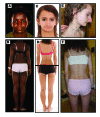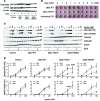Insulin resistance uncoupled from dyslipidemia due to C-terminal PIK3R1 mutations
- PMID: 27766312
- PMCID: PMC5070960
- DOI: 10.1172/jci.insight.88766
Insulin resistance uncoupled from dyslipidemia due to C-terminal PIK3R1 mutations
Abstract
Obesity-related insulin resistance is associated with fatty liver, dyslipidemia, and low plasma adiponectin. Insulin resistance due to insulin receptor (INSR) dysfunction is associated with none of these, but when due to dysfunction of the downstream kinase AKT2 phenocopies obesity-related insulin resistance. We report 5 patients with SHORT syndrome and C-terminal mutations in PIK3R1, encoding the p85α/p55α/p50α subunits of PI3K, which act between INSR and AKT in insulin signaling. Four of 5 patients had extreme insulin resistance without dyslipidemia or hepatic steatosis. In 3 of these 4, plasma adiponectin was preserved, as in insulin receptor dysfunction. The fourth patient and her healthy mother had low plasma adiponectin associated with a potentially novel mutation, p.Asp231Ala, in adiponectin itself. Cells studied from one patient with the p.Tyr657X PIK3R1 mutation expressed abundant truncated PIK3R1 products and showed severely reduced insulin-stimulated association of mutant but not WT p85α with IRS1, but normal downstream signaling. In 3T3-L1 preadipocytes, mutant p85α overexpression attenuated insulin-induced AKT phosphorylation and adipocyte differentiation. Thus, PIK3R1 C-terminal mutations impair insulin signaling only in some cellular contexts and produce a subphenotype of insulin resistance resembling INSR dysfunction but unlike AKT2 dysfunction, implicating PI3K in the pathogenesis of key components of the metabolic syndrome.
Figures





References
Publication types
MeSH terms
Substances
Grants and funding
- RC2 HL102926/HL/NHLBI NIH HHS/United States
- WT098498/WT_/Wellcome Trust/United Kingdom
- BBS/E/B/0000S227/BB_/Biotechnology and Biological Sciences Research Council/United Kingdom
- MC_UU_12012/5/MRC_/Medical Research Council/United Kingdom
- WT098051/WT_/Wellcome Trust/United Kingdom
- BBS/E/B/0000H213/BB_/Biotechnology and Biological Sciences Research Council/United Kingdom
- WT107064/WT_/Wellcome Trust/United Kingdom
- WT091310/WT_/Wellcome Trust/United Kingdom
- RC2 HL103010/HL/NHLBI NIH HHS/United States
- MRC_MC_UU_12012/5/MRC_/Medical Research Council/United Kingdom
- BB/H024824/1/BB_/Biotechnology and Biological Sciences Research Council/United Kingdom
- RC2 HL102923/HL/NHLBI NIH HHS/United States
- UC2 HL102926/HL/NHLBI NIH HHS/United States
- UC2 HL103010/HL/NHLBI NIH HHS/United States
- BBS/E/B/000C0413/BB_/Biotechnology and Biological Sciences Research Council/United Kingdom
- RC2 HL102924/HL/NHLBI NIH HHS/United States
- MC_PC_15018/MRC_/Medical Research Council/United Kingdom
- UC2 HL102923/HL/NHLBI NIH HHS/United States
- UC2 HL102924/HL/NHLBI NIH HHS/United States
- RC2 HL102925/HL/NHLBI NIH HHS/United States
- UC2 HL102925/HL/NHLBI NIH HHS/United States
- G9815508/MRC_/Medical Research Council/United Kingdom
- WT095515/WT_/Wellcome Trust/United Kingdom
LinkOut - more resources
Full Text Sources
Other Literature Sources
Miscellaneous

